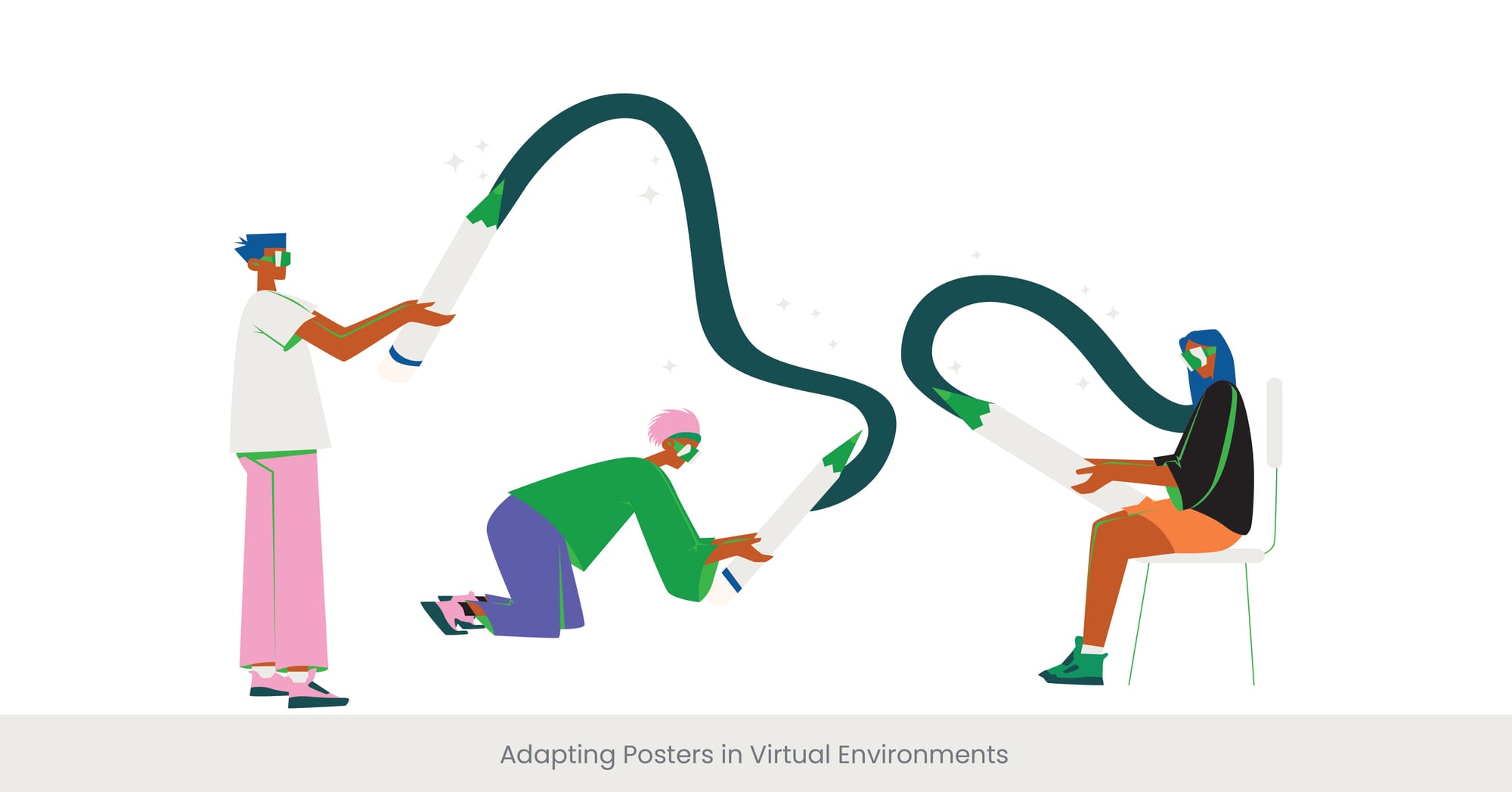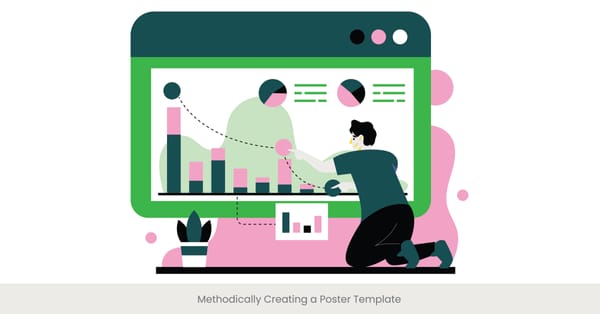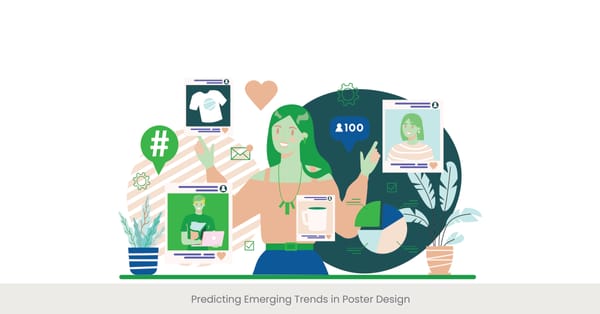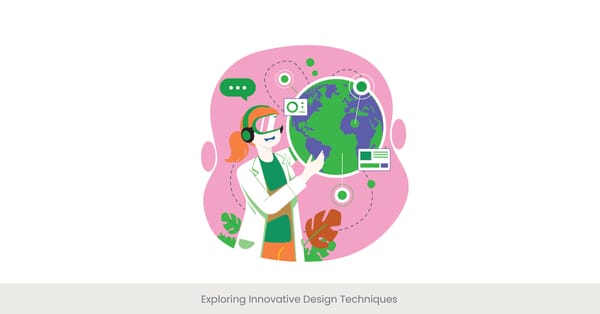
Best Practices for Virtual Poster Presentations

Introduction: Mastering the Art of Virtual Presentation
Virtual poster boards and presentations have become a staple in the academic and professional landscape, offering a unique platform to showcase research and ideas remotely. Mastering this format requires understanding best practices that cater to digital environments. Poster Presentation Services are now essential in ensuring that virtual presentations stand out, with services that focus on design optimization for screen displays.
Background: The Shift to Virtual Formats
With the rise of virtual conferences, the need for effective virtual presentation skills has never been more critical. Traditional poster presentations have evolved to fit digital formats, where design and delivery must be adapted to screens rather than physical spaces. The right Poster Presentation Tools can significantly enhance how research is conveyed, offering features that allow for interactivity and engagement that physical boards simply cannot match.
Real-World Applications and Case Studies
For instance, at a recent international science conference held virtually, presenters utilized high-definition images and short, engaging videos within their posters to capture and maintain audience attention. This approach not only compensated for the lack of physical presence but also leveraged digital tools like Engaging Visuals for Posters to enhance the delivery of complex information. These visuals were enhanced with Infographics for Research Posters, making it easier for attendees to absorb key data points.
Expert Recommendations and Resources
Experts recommend focusing on clarity, simplicity, and interactivity when designing virtual posters. Tools like Adobe Spark and Canva offer user-friendly interfaces that facilitate the creation of visually appealing and informative posters. According to a study published in "Journal of Digital Education," engaging a remote audience requires posters to be not only visually captivating but also easy to navigate and interact with, suggesting that presenters should include features like QR codes or links to additional resources. These Poster Presentation Services ensure that digital presentations are both interactive and educational.
Design Considerations for Online Viewing

Introduction: Tailoring Designs for Digital Audiences
When adapting posters for online viewing, specific design considerations for poster submissions must be taken into account to ensure that they are effective and engaging in a virtual environment. These considerations focus on visual clarity, legibility, and viewer engagement. Using Custom Graphics for Presentations can help create a unique look that stands out in a digital setting, especially when compared to more traditional designs.
Background: The Dynamics of Digital Displays
Digital displays differ significantly from physical displays in how they render colors, detail, and scale. Designers must understand these differences to optimize posters for screens, which may vary widely in size, resolution, and color accuracy across devices. For this reason, it's important to use Poster Presentation Tools that allow for precise control over how content is displayed on different devices, ensuring consistency and clarity.
Real-World Examples of Optimized Design
A notable case involved a virtual gallery where each art piece was displayed as a digital poster. The designers used high-contrast color schemes and large, readable fonts to ensure that the artwork and accompanying descriptions were easily viewable on both desktop and mobile devices. This approach significantly enhanced viewer satisfaction and engagement rates. The use of Infographics for Research Posters was also instrumental in presenting complex information in a digestible format.
Expert Insights and Practical Advice
Experts suggest several key strategies for digital poster design: using vector graphics for clean scaling, ensuring content is responsive to different screen sizes, and minimizing text to reduce cognitive load. Publications like "Designing for Digital Interfaces" recommend tools such as Figma and Sketch for creating designs that are adaptable to various digital formats. Additionally, testing designs on multiple devices before finalizing them is crucial to address any visibility or compatibility issues effectively. Custom Graphics for Presentations can be tailored to meet the unique needs of each presentation, providing added flexibility in design.
Platforms for Hosting Virtual Poster Sessions

Introduction: Selecting the Right Platform
Choosing the right platform for hosting virtual poster sessions is crucial for ensuring effective communication and engagement. The platform must support the specific needs of online poster presentations, including visual clarity, interactivity, and ease of access for attendees. Platforms offering Poster Presentation Services often provide seamless integration with digital design tools to ensure that all elements of a virtual poster presentation are cohesive and effective.
Background: Evolution of Virtual Conference Platforms
As virtual conferences have become more prevalent, numerous platforms have been developed or adapted to better facilitate these events. These platforms vary greatly in terms of functionality, with some offering advanced features like virtual reality environments and real-time interaction capabilities. For example, some platforms offer Poster Presentation Tools that allow for 3D navigation and interactive features that can engage audiences in a more immersive way.
Real-World Applications and Platform Choices
For example, a recent academic conference utilized the platform Gather.town to host virtual poster sessions. This platform provided a unique, spatially navigable virtual environment where attendees could "walk" from one online poster session to another, interact with presenters via video chat, and access posters as if they were in a physical conference hall. Integrating Engaging Visuals for Posters within such a platform can increase the level of engagement and provide a more interactive experience.
Expert Recommendations and Comparative Insights
Experts recommend considering several factors when choosing a platform: user-friendliness, technical support, compatibility with various media formats, and interactive features. "Virtual Conference Solutions," a comparative study, suggests platforms like Zoom for straightforward presentations and more immersive platforms like VirBELA for full-scale conferences. It is also advised to conduct trial runs adapting to virtual conferences to ensure that all participants can navigate the platform effectively before the event. Some platforms offer additional Poster Presentation Services, such as automated poster layout optimization, which can be a significant time-saver for presenters.
Engaging Audiences in a Digital Space

Introduction: Enhancing Engagement in Virtual Settings
Engaging audiences effectively in a digital space is a critical challenge for virtual poster presentations. With the absence of physical presence, poster presenters must leverage digital tools and strategies to capture and maintain audience attention. The integration of Custom Graphics for Presentations can enhance engagement by providing visual stimulation and supporting key messaging.
Background: The Challenge of Digital Engagement
The digital environment poses unique challenges for engagement, including distractions from the immediate environment and the impersonal nature of online interactions. Effective engagement strategies are essential to overcome these hurdles and ensure meaningful audience interaction. By incorporating Infographics for Research Posters, presenters can make complex data more accessible, encouraging deeper audience involvement.
Real-World Examples of Successful Engagement
At a virtual medical conference, presenters used interactive polls and live Q&A sessions to engage the audience actively. These interactive elements were integrated directly into the poster sessions, allowing attendees to participate in real-time discussions and provide instant feedback pre recorded presentations, which significantly increased engagement and retention of the presented information. The use of Engaging Visuals for Posters during these interactive sessions helped maintain viewer interest.
Expert Insights and Recommendations
Experts emphasize the importance of interactivity and personal connection in digital presentations. Techniques such as direct questions to the audience, interactive elements like polls or quizzes, and using Engaging Visuals for Posters are highly recommended. "Digital Engagement Techniques," a guide by renowned digital marketers, suggests using platforms that allow customization of the presentation space to include interactive features and recommends regular engagement checks, like quick surveys during the session, to keep the audience involved.
Virtual Reality as a Medium for Posters

Introduction: Immersive Experiences with Virtual Reality
Virtual Reality (VR) offers a groundbreaking medium for poster presentations, providing an immersive environment that can significantly enhance the way information is perceived and interacted with by the audience.
Background: The Advent of VR in Presentations
The integration of VR technology in presentations has revolutionized the traditional, poster presentation format. By creating a 3D virtual space, presenters can design experiences that are not only visually engaging but also interactive, allowing viewers to explore data and concepts in a fully immersive way.
Real-World Applications and Innovations
For instance, at a recent technology expo, a team of data scientists presented their complex datasets using VR. Attendees wore VR headsets to navigate through data visualizations that appeared as three-dimensional structures around them. This method made it easier for viewers to understand patterns and relationships within the data, providing a more intuitive grasp of intricate information.
Expert Insights and Practical Guidance
Experts in educational technology advocate for the thoughtful incorporation of VR into poster presentations to maximize its benefits without overwhelming the audience. Key considerations include ensuring the content is suitable for a 3D format and keeping the user interface simple to avoid cognitive overload. "Exploring VR in Education," a scholarly article, recommends platforms like Oculus Rift and HTC Vive for their high-quality graphics and user-friendly controls, which are ideal for academic and professional presentations.
Explore how INK PPT transforms hybrid presentations for seamless audience engagement.
Hybrid Presentations: Bridging Physical and Virtual

Introduction: The Best of Both Worlds
Hybrid presentations blend physical and virtual elements to create a comprehensive experience that accommodates both in-person and remote audiences. This approach maximizes reach and inclusivity, allowing presenters to engage with participants across multiple platforms.
Background: Evolution of Hybrid Events
The rise of hybrid events has been fueled by advances in technology and the need for greater flexibility in the face of global challenges like travel restrictions. Hybrid formats enable organizations to offer more resilient and adaptable conferencing options, combining live interactions with digital accessibility.
Real-World Examples of Successful Hybrid Implementation
A notable example of hybrid presentation success was seen at an international environmental conference. The event featured speakers presenting live in a conference hall, with simultaneous streaming and interactive elements available for online attendees. This setup allowed for real-time questions and discussions from both audiences, significantly enhancing the collaborative aspect of the conference.
Expert Insights and Recommendations
Experts recommend using integrated platforms that can seamlessly manage both live and virtual interactions, such as Microsoft Teams or Zoom. These platforms should support features like live streaming, chat functions, and Q&A sessions. "Hybrid Presentation Dynamics," a recent publication, emphasizes the importance of preparing presenters to engage with both types of audiences effectively and suggests rehearsals to ensure smooth transitions between physical and digital components.
Want to elevate your hybrid presentations?
Analytics: Measuring Success in the Virtual Realm

Introduction: The Role of Analytics in Virtual Events
In the virtual realm, analytics play a crucial role in measuring the success of events and presentations. These data-driven insights help organizers and presenters understand audience engagement, content effectiveness, and overall reach.
Background: The Importance of Data in Virtual Environments
With the shift to digital platforms, the ability to collect and analyze detailed metrics has become integral to optimizing and tailoring experiences for virtual audiences. Key performance indicators (KPIs) such as attendance rates, interaction levels, and viewer retention provide valuable feedback for continuous improvement.
Contact INK PPT for tailored analytics solutions to optimize your virtual events.
Real-World Applications and Impact
For example poster online, during a recent virtual academic symposium, organizers utilized analytics to track viewer participation across different sessions. They could identify which topics garnered the most interest and interaction, which informed decisions for future event planning and content adjustments.
Expert Insights and Practical Advice
Experts in digital event management recommend leveraging specialized tools like Google Analytics for web-based events or built-in analytics features in platforms like Zoom or WebEx for webinars and virtual meetings. "Navigating Virtual Analytics," a guide published by a leading tech firm, suggests setting clear objectives for what metrics to track and regularly reviewing these metrics to adjust strategies in real-time. Additionally, privacy and ethical considerations should always be respected when collecting and using attendee data.
Unlock data-driven insights for virtual success with INK PPT's expert guides
Digital Accessibility and Inclusivity Practices

Introduction: Ensuring Access for All
Digital accessibility and inclusivity are critical in designing virtual poster presentations to ensure that everyone, regardless of disability or technical limitations, can fully participate and benefit. These practices are not just ethical imperatives but also enhance the overall reach and effectiveness of presentations, ensuring accessibility for all attendees.
Background: The Importance of Inclusive Design
Inclusivity in digital design involves creating content that is accessible to people with a wide range of physical and cognitive abilities. This includes considerations for visual, auditory, and motor impairments, as well as ensuring content is understandable and navigable for all.
Real-World Examples of Accessible Design
A notable implementation was at a global health conference, where all virtual posters were designed with alt-text for images, captions for videos, and screen reader-friendly layouts. This approach not only complied with international accessibility standards but significantly improved engagement from a diverse audience.
Expert Insights and Recommendations
Experts advocate for the adoption of Web Content Accessibility Guidelines (WCAG) when designing digital content. Tools like Adobe Acrobat for PDF accessibility, and web-based accessibility checkers, such as WAVE, can help designers ensure their work meets these standards. "Design for All: Accessibility in the Digital Age," a comprehensive guide, recommends regular training for design teams on accessibility practices and testing designs with users who have disabilities to gather authentic feedback and make necessary adjustments.
Networking Opportunities in Virtual Conferences

Introduction: Building Connections Remotely
Networking is a fundamental aspect of any conference, providing valuable opportunities for collaboration and career advancement. In virtual conferences, creating effective networking opportunities requires innovative approaches to simulate the spontaneous and interactive nature of in-person events.
Background: Adapting Networking to Digital Formats
The transition to virtual formats has challenged traditional networking paradigms, necessitating new tools and methods to facilitate meaningful interactions. Virtual environments must be carefully designed to encourage engagement and mimic the networking dynamics of physical conferences.
Real-World Examples of Effective Virtual Networking
At a recent tech industry summit, the organizers used a platform that allowed attendees to create virtual "meeting rooms" where they could engage in video chats, share contact information, and even collaborate on documents in real-time. This setup enabled participants to form connections and discuss potential collaborations as effectively as they would have in a physical venue.
Expert Insights and Practical Advice
Experts recommend utilizing platforms that offer various interactive features, such as breakout rooms, virtual "coffee breaks," and speed networking sessions, to enhance virtual networking. Tools like Hopin or Remo are praised for their comprehensive features that facilitate interaction among participants. Additionally, "Virtual Networking Success," a publication by a renowned business strategist, suggests providing attendees with tips on how to effectively use these tools before the event to maximize their networking potential.
Discover INK PPT's innovative virtual networking strategies for your next event.
Future of Conferences: The Rise of Virtual Spaces

Introduction: Shaping the Future with Virtual Conferences
The shift towards virtual spaces is reshaping the landscape of conferences, offering new possibilities for global interaction and inclusivity. This evolution suggests a future where virtual and hybrid models may become the norm, providing broader accessibility and flexibility.
Background: The Advancement of Virtual Conference Technology
Advancements in technology have propelled the popularity of virtual conferences, driven by the need for cost-effective, scalable, and environmentally friendly alternatives to traditional events. These platforms can accommodate thousands of participants from across the globe, breaking down geographical and logistical barriers.
Real-World Impact and Trends
A prominent example is the annual Global Tech Symposium, which transitioned to a fully virtual format. The event saw a 40% increase in attendance and a significant reduction in carbon footprint by eliminating the need for travel and on-site resources. This success has prompted many organizations to consider permanent shifts to at least partially virtual formats.
Expert Opinions and Future Predictions
Experts predict that virtual and hybrid conferences will continue to evolve, incorporating more sophisticated technologies like AI for personalized experiences and VR for more immersive sessions. "The Future of Conferences," a white paper by an industry think tank, forecasts that by 2030, most professional gatherings will offer virtual participation options, with many smaller conferences moving entirely online. The research paper emphasizes the importance of continuous innovation in digital engagement strategies to keep these formats compelling and effective.
Thanks for checking out our guide! If it resonated with you, please feel free to share it with others.
Want more on Design Techniques, Check out these additional guides you may find interesting:
Exploring Innovative Design Techniques
Proactively Avoiding Common Design Mistakes
Frequently Asked Questions
1. How do you prepare for a virtual conference?
To prepare for a virtual conference, ensure you have a reliable internet connection, familiarize yourself with the conference platform, and prepare and upload your presentation materials in a format suitable for online display. Also, practice navigating the digital tools and features you'll use to present or interact with attendees.
2. What are the benefits of virtual conferences?
Virtual conferences offer significant benefits such as reduced costs for both organizers and attendees, increased accessibility for participants from around the world, and enhanced opportunities for recording and sharing sessions. They also have a lower environmental impact compared to traditional in-person events.
3. How do you engage virtual conference attendees?
Engage virtual conference attendees by incorporating interactive elements such as polls, Q&A sessions, and breakout rooms. Use engaging visuals and concise content to maintain attention, and encourage networking through virtual meetups or social media groups.
4. What makes a good virtual conference?
A good virtual conference provides a seamless user experience, high-quality content, interactive sessions, and networking opportunities. It should be free, well-organized, with technical support readily available, and offer various engagement tools to keep participants interested and involved.
5. How to present a poster in a virtual conference?
Present a poster in a virtual conference by using clear, high-resolution images and concise text. Make use of virtual poster templates and session tools that allow for interactive elements like video explanations or live chat. Ensure your poster is accessible and easy to navigate in a digital format.
6. How do I make an online presentation poster?
Create an online presentation poster by focusing on the details, design clarity, using readable fonts, and including interactive elements if possible. Tools like Canva or Adobe Spark provide templates and features suited for creating visually appealing and effective online posters.
7. What is a digital interactive poster?
A digital interactive poster combines graphics, text, and multimedia elements that viewers can interact with, such as clickable links, embedded videos, and animation. This format enhances engagement with visitors and allows for a deeper exploration of the content.
8. How do you display posters at a conference?
Display posters at a virtual conference by uploading your printed poster to the conference platform, where it can be accessed by attendees. Include interactive elements like zoom features and clickable content for enhanced viewer engagement.
9. What are three things we should sometimes do in a digital presentation?
In a digital presentation, you should sometimes use animations to clarify complex points, incorporate video or audio clips for variety, and engage the audience with live polls or quizzes to maintain interest and interaction.
10. What are the 4 P's approach for effective presentation?
The 4 P's approach for effective presentation includes Planning your content carefully, Practicing your delivery, Personalizing the experience for your audience, and Performing with confidence and clarity during the presentation.



%20(1).jpg)
%20(1).jpg)


